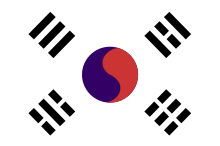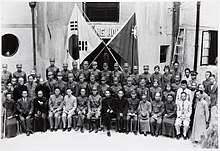Korean Liberation Army
The Korean Liberation Army, established on September 17, 1940 in Chungking, China, was the armed force of the Provisional Government of the Republic of Korea. Its commandant was General Ji Cheong-cheon, with General Lee Beom-seok, a hero of the Battle of Cheongsanri and future prime minister of South Korea as the Chief of Staff. Effectively a part of the Chinese forces upon which it was dependent, the army was limited by available manpower and did not get much above 339 strong. The KLA became the basis of the modern day Republic of Korea Armed Forces.[1]
| Korean Liberation Army | |
|---|---|
 Flag of the Provisional Government of the Republic of Korea | |
| Active | 1940 - 1946 |
| Allegiance | Provisional Government of the Republic of Korea |
| Branch | Infantry |
| Type | Infantry |
| Role | Guerrilla warfare, special operations |
| Size | 339 |
| Part of | ( |
| Motto(s) | "대한독립만세" (Korean) "Long live the Korean Independence" |
| March | Le Chant des Partisans |
| Commanders | |
| Founder | Kim Gu |
| President | Baekbeom Kim Koo |
| Commandant | Ji Cheong-cheon |
| Notable commanders | Lee Bum-suk, Kim Won-bong Kim Hak-gyu Park Si-chang Kim Hong-il |
| Insignia | |
| Coat of arms |  |
| Korean Liberation Army | |
 Korean Liberation Army | |
| Korean name | |
|---|---|
| Hangul | 한국광복군 |
| Hanja | 韓國光復軍 |
| Revised Romanization | Han(-)guk Gwangbokgun |
| McCune–Reischauer | Han'guk Kwangbokkun |
Early days
The KLA brought together many Korean guerrilla armies that proliferated in northern Korea, Manchuria and mainland China during the 1920s. After the declaration of war by the Provisional Government against Japan and Germany on December 9, 1941, the units of the KLA participated on the allied side in the Chinese and Southeast Asian theatres. The Regulation regarding the activities of the Korean Liberation Army, imposed by the Chinese Nationalist Government upon the provisional government in 1941, placed the KLA under the supreme authority of the Commander-in-chief of the Chinese army. This regulation was repealed in 1944, after the provisional government had achieved improved financial standing and greater importance in the eyes of the Chinese government.[1]
During this period the KLA sent troops to fight alongside British soldiers in the South-East Asian theatre of World War II by request of the British Army, including the outskirts of Burma and India (especially the Battle of Imphal in the Burma Campaign). In 1943, socialist-aligned guerrilla groups joined the KLA, and their leader, General Kim Wonbong, became the deputy commandant of the KLA. Its numbers were continuously boosted by the influx of Koreans escaping from the Japanese army (into which some in mainland Korea had been impressed) and through the recruitment of Koreans living in China. From its beginnings with an officer corps of 30 men at its foundation in 1941, the KLA grew to a substantial force with 339 in active service by the end of the war.
End of World War II
In 1945, the KLA was working in cooperation with the US Office of Strategic Services to train men for specialist military operations within Korea. The leading units were due to depart on August 20, with General Lee in command.
The KLA's goal was achieved with the Japanese surrender on September 2, 1945. However, The USSR quickly attacked Japanese forces and gained the Northern part of the Korean Peninsula this decision made the USA use the Atomic bombings of Hiroshima and Nagasaki and won the early surrender of the Japanese Empire and blocked the USSR attempted strongly influence of Korean Peninsula. On August 15, 1945, the Japanese empire collapsed and the Korea finally gained the Korean Peninsula. This independence was reaffirmed in the Treaty of San Francisco. After the end of World War II, KLA disbanded on June 1946.[1][2][3]
Post-war

The members of the KLA returned to Korea during late 1945 and 1946. Many of its members, including Generals Ji and Lee, became part of the South Korean government, while General Kim contributed to the North Korean regime of Kim Il-sung, who himself claimed to have been a KLA commander.
There has been a movement in South Korea for years to change the National Armed Forces Day from October 1 to September 17 in honor of the foundation of the Korean Liberation Army in 1941.
Army ranks
- General (정장)
- Lieutenant General (부장)
- Major General (참장)
- Colonel (정령)
- Lieutenant Colonel (중령)
- Major (참령)
- Captain (정위)
- First Lieutenant (부위)
- Second Lieutenant (부사)
- Warrant Officer (준위)
- Master Gunnery Sergeant (특무상사)
- Master Sergeant (상사)
- Sergeant First Class (중사)
- Staff Sergeant (하사)
- Corporal (상등병)
- Private First Class (일등병)
- Private (이등병)
See also
- List of Korea-related topics
- History of Korea
- Korean independence movement
- Provisional Government of the Republic of Korea
- Righteous army
References
- "한국광복군" [Korean Liberation Army]. terms.naver.com (in Korean). Retrieved 2019-05-24.
- "한국광복군 창건일과 국군의 날".
- "[오늘의 경제소사] 1945년 일본 몰락 작전".